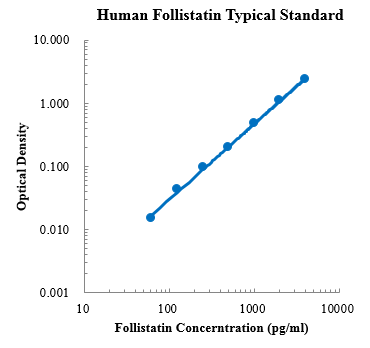
Human Follistatin ELISA Kit
$350.00 – $450.00
| Sample Type | Serum, plasma, cell culture supernatant, and other biological samples |
|---|---|
| Sample Volume | 20 μL |
| Sensitivity | 4.99 pg/mL |
| Range | 62.5 pg/mL – 4000 pg/mL |
| Assay Time | 3.5 h |
| Recovery | 87% – 125% |
| Average Recovery | 1.08 |
| Intra Precision | 4.0% – 5.2% |
| Inter-Precision | 4.5% – 6.5% |
| Platform | ELISA |
| Plate | Detachable 96-well plate |
| Size | 96T/48T |
| Storage | If the reagent kit is unopened, it should be stored at 4℃. However, if it has been opened, the standard solution should be stored at -20℃, while the other components should be stored at 4℃. |
| Delivery | 4℃ blue ice transportation |
| Components | 96-well polystyrene enzyme-linked immunosorbent assay (ELISA) plate coated with anti-Follistatin monoclonal antibody Human Follistatin freeze-dried standard Follistatin detect Antibody Standard Diluent Assay Buffer(10×) Substrate TMB Stop Solution Washing Buffer(20×) Sealing Film |
| Assay Principle | This kit utilizes the double antibody sandwich enzyme-linked immunosorbent assay (ELISA) detection technique.Specific anti-human Follistatin antibodies are precoated on a high-affinity ELISA plate. Standard samples, test samples, and biotinylated detection antibodies are added to the wells of the ELISA plate. After incubation, Follistatin present in the samples binds to the solid-phase antibodies and the detection antibodies. After washing to remove unbound substances, streptavidin-HRP labeled with horseradish peroxidase is added. After washing, a colorimetric substrate, TMB, is added and the plate is incubated in the dark for color development. The intensity of the color reaction is directly proportional to the concentration of Follistatin in the samples.A stop solution is added to terminate the reaction, and the absorbance value is measured at a wavelength of 450 nm (with a reference wavelength range of 570-630 nm). |

Targets
FST
FST Target Infomation Overview
- Target Symbol: FST, follistatin
- Alias: FS
FST, follistatin Target Infomation by Species
Human FST Target Information
- Target Symbol: FST, follistatin
- Alias:
- activin-binding protein
- follistatin isoform FST317
- FS
- NCBI_Gene: 10468
- UniProtKB: P19883
Human FST Predicted Functions
Enables activin binding activity and activin receptor antagonist activity. Involved in hematopoietic progenitor cell differentiation; negative regulation of activin receptor signaling pathway; and negative regulation of transcription by RNA polymerase II. Acts upstream of or within positive regulation of hair follicle development. Predicted to be located in extracellular region. Predicted to be active in extracellular space. Implicated in polycystic ovary syndrome.
Mouse Fst Target Information
- Target Symbol: Fst, follistatin
- Alias:
- 无
- NCBI_Gene: 14313
Mouse Fst Predicted Functions
Predicted to enable activin binding activity; activin receptor antagonist activity; and heparan sulfate proteoglycan binding activity. Acts upstream of or within several processes, including BMP signaling pathway; animal organ development; and keratinocyte proliferation. Located in cytoplasm and nucleus. Is expressed in several structures, including alimentary system; brain; early conceptus; embryo mesenchyme; and genitourinary system. Used to study lethal restrictive dermopathy. Human ortholog(s) of this gene implicated in polycystic ovary syndrome. Orthologous to human FST (follistatin).
Rat Fst Target Information
- Target Symbol: Fst, follistatin
- Alias:
- activin-binding protein
- FOL1
- follistatin-A
- FS
- Fst-288
- LOC686745
- RATFOL1
- similar to follistatin
- NCBI_Gene: 24373
- UniProtKB: P21674
Rat Fst Predicted Functions
Enables heparan sulfate proteoglycan binding activity. Predicted to be involved in hematopoietic progenitor cell differentiation; negative regulation of transcription by RNA polymerase II; and regulation of transmembrane receptor protein serine/threonine kinase signaling pathway. Predicted to act upstream of or within several processes, including animal organ development; keratinocyte proliferation; and positive regulation of hair follicle development. Predicted to be located in cytoplasm and nucleus. Predicted to be active in extracellular space. Human ortholog(s) of this gene implicated in polycystic ovary syndrome. Orthologous to human FST (follistatin).



